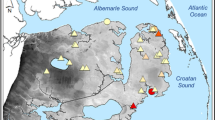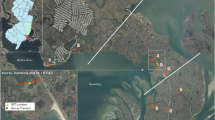Abstract
We studied the key environmental variables shaping plant assemblages in Mediterranean abandoned ricefields with contrasting freshwater inputs over saline sediments. Plant species cover, water levels and soil variables were studied following a stratified random sampling design. Multivariate analysis identified water regime, particularly summer and autumn irrigation, as the most important environmental variable associated with vegetation composition. Distribution of annual and emergent macrophytes was not associated to salinity as found at the study site (0.57–4.1 mS/cm). Increased soil salinity, caused by summer irrigation near the soil surface did affect shallow-marsh assemblage distribution. These key environmental characteristics allowed us to identify six main assemblages. Annual macrophytes (such as Zannichellia palustris) were defined by high (over 10 cm) annual mean water level (MWL) and early successional conditions; emergent macrophytes (such as Typha spp., Scirpus lacustris) by annual MWL of 10 to − 25 cm and continuous shallow flooding in summer and autumn (MWL of 0–10 cm). The shallow-marsh group, correlated with annual MWL − 25 to − 100 cm, separated into two subgroups by salinity: grassland (including Paspalum distichum) with summer and autumn MWL below − 25 cm and brackish (with Juncus subulatus or Agrostis stolonifera) with summer and autumn MWL just below the soil surface (0 to − 25 cm). Water levels for the grassland subgroup may equate with a salinity ‘refuge’ for P. distichum. Time was a further determinant of variation in the full data set. Abundance of a large group of agricultural annuals (such as Sonchus tenerrimus) and damp ground annuals (including ricefield weeds such as Ammania robusta) decreased with time as bare ground disappeared. Maintenance of spatial vegetation heterogeneity in abandoned ricefields is contingent on continued water regime management.
Similar content being viewed by others
References
Bach J (1990) L’ambient hidrogeològic de la Plana de l’Alt Empordà. PhD Universitat Autònoma de Barcelona
Bolen EG (1964) Plant ecology of spring-fed salt marshes in Western Utah. Ecol Monogr 34:143–166
Bolòs O, Vigo J (1984) Flora dels Països Catalans. Ed. Barcino, Barcelona
Casanova MT, Brock MA (2000) How do depth, duration and frequency of flooding influence the establishment of wetland plant communities? Plant Ecol 147:237–250
Chambers JM, McComb AJ (1994) Establishment of wetland ecosystems in lakes created by mining in Western Australia. In: Mitsch WJ (ed) Global wetlands: old world and New. Elsevier Science B.V., Amsterdam
Comín FA, Romero JA, Hernández O, García C (1997) Preferential habitat of aquatic birds in restored wetlands. Wetl Int Publ 43:337–351
Consorci de la Costa Brava (1998) Seguiment de la qualitat ecològica de les aigües en la zona del Parc Natural dels Aiguamolls de l’Empordà. Consorci de la Costa Brava, pp 120
Fiala K, Kêt J (1971) Dynamic balance between plant species in South Moravian reedswamps. In: Duffy E, Watt AS (eds) The scientific management of animal and plant communities for conservation: 11th Symposium of the British Ecological Society UEA, A.S. Blackwell Scientific Publishers, pp 241–269
Gordon DH, Gray BT, Perry RD, Prevost MB, Strange TH, Williams RK (1989) South Atlantic coastal wetlands. In: Smith LM, Pederson RL, Kaminski RM (eds) Habitat management for migrating and wintering waterfowl in North America. Texas Tech University Press, Lubbock, pp 57–92
Grace JB, Wetzel RG (1981) Phenotypic and genotypic components of growth and reproduction in Typha latifolia: experimental studies in marshes of differing successional maturity. Ecology 62:789–801
Grace JB, Wetzel RG (1982) Niche differentiation between two rhizomatous species: Typha latifolia and Typha angustifolia. Can J Bot 60:46–57
Grillas P, Van Wijck C, Bonis A (1991) Life history traits: a possible cause for the higher frequency of ocurrence of Zannichellia pedunculata than of Zannichellia obtusifolia in temporary marshes. Aquat Bot 42:1–13
Harris SW, Marshall WH (1963) Ecology of water level manipulations on a northern marsh. Ecology 44:331–343
Havens KJ, Preist WI, Berquist H (1997) Investigation and long-term monitoring of Phragmites australis within Virginia’s Constructed Wetland Sites. Environ Manag 21:599–605
Jenny H (1980) The soil resource. Springer-Verlag, New York
Jongman RHG, ter Braak CJF, van Tongeren OFR (1995) Data analysis in community and landscape ecology. Cambridge University Press, Cambridge, pp 299
Kadlec JA (1962) Effects of a drawdown on a waterfowl impoundment. Ecology 43:267–281
Kadlec JA (1982) Mechanisms affecting salinity of Great Salt Lake Marshes. Am Mid Nat 107:82–94
Kadlec JA, Smith LM (1989) The Great Basin Marshes. In: Smith LM, Pederson RL, Kaminski RM (eds) Habitat management for migrating and wintering waterfowl in North America. Texas Tech University Press, Lubbock, pp 451–474
Keddy PA (1984) Plant zonation on lakeshores in Nova Scotia: a test of the resource specialization hypothesis. J Ecol 72:797–808
Keddy PA, Ellis TH (1985) Seedling recruitment of 11 wetland species along a water level gradient: shared or distinct responses? Can J Bot 63:1876– 1879
Lieffers VJ, Shay JM (1982) Distribution and variation in growth of Scirpus maritimus var. paludosus on the Canadian praries. Can J Bot 60:1938–1949
Mas-Pla J, Bach J, Viñals E, Trilla J, Estalrich J (1999) Salinization processes in a coastal leaky aquifer system (Alt Empordà, NE Spain). Phys Chem Earth 24(4):337–341
McCoy MB, Rodríguez JM (1994) Cattail (Typha dominguensis) eradication methods in the restoration of a tropical, seasonal, freshwater marsh. In: Mitsch WJ (ed) Global wetlands: old world and new. Elsevier Science B.V. pp 469–482
Mesléard F, Grillas P, Tan Ham L (1995) Restoration of seasonally-flooded marshes in abandoned ricefields in the Camargue (southern France) – preliminary results on vegetation and use by ducks. Ecol Eng 5:95–106
Mesléard F (1994) Agricultural abandonment in a wetland area: abandoned ricefields in the Camargue, France – Can they be of value for conservation? Environ Conserv 21:354–357
Mesléard F, Grillas P, Lepart J (1991) Plant community succession in a coastal wetland after abandonment of cultivation: the example of the Rhone delta. Vegetatio 94:35–45
Mesléard F, Tan Ham L, Boy V, Van Wijck C, Grillas P (1993) Competition between an introduced and an indiginous species: the case of Paspalum paspalodes (Michx) Schribner and Aeluropus littoralis (Gouan) in the Camargue (southern France). Oecologia 94:204–209
Middleton BA, Van der Valk AG, Mason DH, Williams RL, Davis CB (1991) Vegetation dynamics and seed banks of a monsoonal wetland overgrown with Paspalum distichum L. in northern India. Aquat Bot 40:239–259
Millar JB (1973) Vegetation changes in shallow marsh wetlands under improving moisture regime. Can J Bot 51:1443–1457
Mitsch WJ, Gosselink JG (1993) Wetlands. Van Nostrand Reinhold, New York
Odland A, del Moral R (2002) Thirteen years of wetland vegetation succession following a permanent drawdown, Myrkdalen Lake, Norway. Plant Ecol 162:185–198
Palmer MW (1998) Canonical correspondence analysis: some advice and guidelines. In: Kazmiercźak E, Nienartowicz A, Piernik A, Wilkon-Michalska JToru (eds) Computer methods in investigation of the structure and functioning of the vegetation cover. Nicholas Copernicus University, Poland, pp 171–187
Pederson RL, Jorde DG, Simpson SG (1989) The Northern Great Plains. In: Smith LM, Pederson RL, Kaminski RM (eds) Habitat management for migrating and wintering waterfowl in North America. Texas Tech University Press, Lubbock, Texas, pp 281–310
Quintana X, Moreno R, Comín F (1998) Nutrient and plankton dynamics in a Mediterranean salt marsh dominated by incidents of flooding. Part 1: differential confinement of nutrients. J Plankton Res 20:2089–2107
Ribas-de-Pouplana L, Abella C, Moreno R (1986) Limnology of a rice field: a case approach to “Aiguamolls de l’Alt Empordà” (Girona, Catalonia). Scientia Gerundensis 12:113–121
Sargatal J (1995) Los proyectos de Restauración de Humedales en el Parque Natural de los Aiguamolls de l’Empordà (Girona). In: Montes C, Oliver G, Molina F, Cobos J (eds) Bases Ecológicas para la Restauración de Humedales en la Cuenca Mediterránea. Consejería de Medio Ambiente, Junta de Andalucia, pp 263–270
Seabloom EW, Van der Valk AG, Moloney KA (1998) The role of water depth and soil temperature in determining initial composition of prarie wetland coenoclines. Plant Ecol 138:203–216
Shay JM, Shay CT (1986) Prarie marshes in western Canada, with specific reference to the ecology of five emergent macrophytes. Can J Bot 64:443–454
ter Braak CJF, Looman CWN (1986) Weighted averaging, logistic regression and the Gaussian response model. Vegetatio 65:3–11
ter Braak CJF, Prentice C (1988) A theory of gradient analysis. Adv Ecol Res 18:271–317
ter Braak CJF, Smilauer P (1998) CANOCO for Windows 4.0. Centre for Biometry, Wageningen, The Netherlands
Van Wijck C, De Groot CJ (1993) The impact of dessication of a freshwater marsh (Garcines Nord, Camargue, France) on sediment–water–vegetation interactions Part 2: the submerged macrophyte vegetation. Hydrobiologia 252:95–103
Van Wijck C, De Groot CJ, Grillas P (1992) The effect of anaerobic sediment on the growth of Potamogeton pectinatus L.: the role of organic matter, sulphide and ferrous iron. Aquat Bot 44:31–49
Vaqué E, Roca A, Ribera E (1989) El poblament humà actual. In: Sargatal J, Fèlix J (eds) Els Aiguamolls de l’Empordà. Aspectes ecològics, històrics i socials. Carles Vallès, Figueres (Spain), pp 119–168
Walker BH, Coupland RT (1968) An analysis of vegetation–environment relationships in Saskatchewan sloughs. Can J Bot 46:509–522
Walker BH, Coupland RT (1970) Herbaceous wetland vegetation in the aspen grove and grassland regions of Saskatchewan. Can J Bot 48:1861–1878
Acknowledgements
We thank G. Pardini for use of the soil laboratory, Tete and Esther for all their help there, M. Poch for use of the Chemical Engineering laboratory, and Xavi Quintana and Joan Bach for access to unpublished data. The research was partly supported by Aiguamolls de l’Empordà Natural Park (AENP). We are indebted to colleagues at the AENP for their helpful support: J. Espigulé, J. Sargatal, S. Romero, E. Brunso, A. Colomer, Biel for technical advice and field measurements; J. Martí with bird observations; and Gemma, Christopher and Maite for field assistance.
Author information
Authors and Affiliations
Corresponding author
Rights and permissions
About this article
Cite this article
Watt, S.C.L., García-Berthou, E. & Vilar, L. The influence of water level and salinity on plant assemblages of a seasonally flooded Mediterranean wetland. Plant Ecol 189, 71–85 (2007). https://doi.org/10.1007/s11258-006-9167-7
Received:
Accepted:
Published:
Issue Date:
DOI: https://doi.org/10.1007/s11258-006-9167-7




